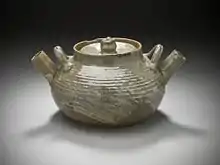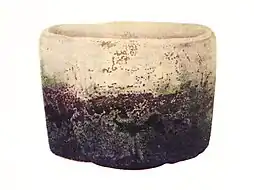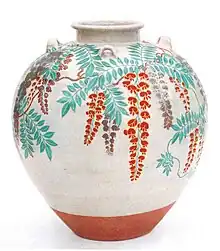
Akahada ware (赤膚焼, Akahada-yaki) is a type of Japanese pottery traditionally from Nara Prefecture focused on primarily Tea Ceremony ware.
History
Starting in 1585 Akahada ware was created by several kilns and became a favorite of Korobi Enshū There was a serious decline due to the political changes in the mid 18th century, causing the kilns to be moved around and changed. In 1785 the feudal lord in Koriyama castle in Nara Yanagisawa Yasumitsu, asked two potters named Inosuke and Jihee to revitalize the kilns. The kilns were eventually moved to Koriyama and had a central, eastern, and western kiln. The central kiln was run by Okuda Mokuhaku. The western kiln was run by the two potters Sobei and Shijiro After 1785 the kilns had the patronage of the daimyo of Koriyama castle where they remain in production today.[1]
Characteristics
The clay is milky white, sometimes with a hint of red, with clear glaze.[2] The most common form is tea wares such as cups, jars, and bowls. A common defining feature is Nara-e drawings painted onto the surface under the glaze featuring scenes from fairy tales, noh songs, and other similar sources.[3]
Current makers and productions
Currently, there are six Akahada ware kilns operating in Nara today. The eight-generation Furuse kiln, the fourth-generation Oshiro Akiyama kiln, another Oshiro kiln, the ninth-generation Oshiro Sheijin kiln, the fourth-generation Ogawa kiln, and the eight-generation Onishi kiln.[1]
References
- 1 2 Pike, Dave. "Akahada Ware (a shortened form for Akahada yama ware)". Akahada Ware - Guide to Value, Marks, History. Worthpoint. Retrieved 6 December 2021.
- ↑ Yamamoto, Kana. "Akahada Ware, a Traditional Craft of Nara". Nara-Sightseeing. Kanasai Nara Treasure Travel. Retrieved 6 December 2021.
- ↑ "Akahada Pottery". Dictionary of Japanese Potters. Japanese-Ceramics. Retrieved 6 December 2021.
External links
![]() Media related to Akahada ware at Wikimedia Commons
Media related to Akahada ware at Wikimedia Commons

